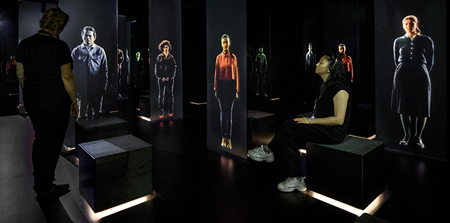

FLUGT Refugee Museum of Denmark
Tinker imagineers
Client: Varde MuseumsExhibition design & audiovisual design: Tinker imagineersSet construction: KloosterboerHardware & showcontrol: StouenborgAV content (first two rooms): ShoshoInteractive table: YIPPArt installation wireframe figures: Rina van der WeijLighting design: 50luxAudio design: Big OrangeAudio device: TonweltCopywriting audio stories: Story MattersArchitect: BIG - Bjarke Ingels Group
The new museum FLUGT is created by Varde Museums, also behind Tirpitz. After World War II, the site of the museum housed the largest refugee camp for German civilians in Denmark. Tinker was asked to create a concept for the exhibitions inside the museum and for the storytelling in the former refugee camp, now a forest of 4.5 km2.
FLUGT wanted to be the first museum in the world dedicated to refugees’ stories: both contemporary and historical. Telling the story of refugees today can be a challenging task. By combining this narrative with the stories of refugees from World War II, the museum helps visitors recognize the many similarities between refugees then and now.
The need for such a museum has become increasingly relevant as the number of refugees continues to grow. However, creating a new museum around such a sensitive subject comes with its own set of challenges. How can we fully immerse visitors in a sensitive story that is both contemporary and historical? How do we represent reality without taking stance? Tinker came up with an innovative immersive design that tells the stories of refugees of all ages in a way people have never experienced before. As part of this, the use of audio functions as the backbone of the experience design rather than just in support.
The museum experience consists of several exhibition rooms and a large outdoor area. The refugees' personal stories are brought to life with visual highlights, soundscapes, animations, interviews, and original film material. Outside, a notable model of the former camp, made of concrete and Corten Steel, indicates its scale. Here starts an immersive audio walk through the forest. Visitors hear sounds and voices, experiencing history through the eyes of former camp refugees. This was what daily life in the camp was like.